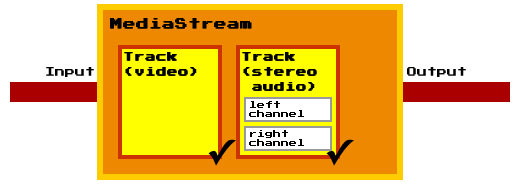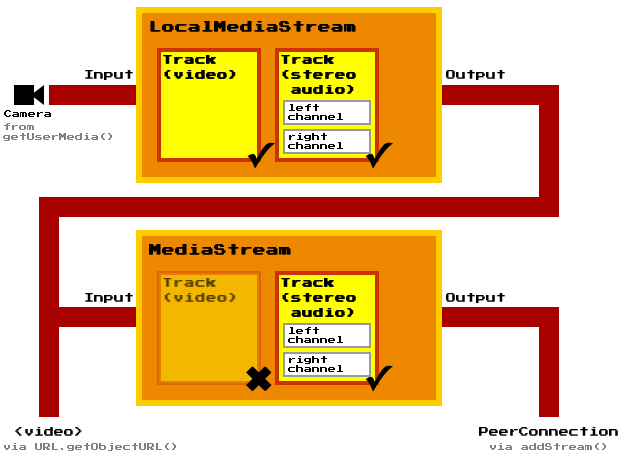3.1 Introduction
The MediaStream interface is used to
represent streams of media data, typically (but not necessarily) of audio and/or video
content, e.g. from a local camera or a remote site. The data from a MediaStream object does not necessarily have a canonical
binary form; for example, it could just be "the video currently coming from the user's
video camera". This allows user agents to manipulate media streams in whatever fashion
is most suitable on the user's platform.
Each MediaStream object can represent zero
or more tracks, in particular audio and video tracks. Tracks can contain multiple
channels of parallel data; for example a single audio track could have nine channels of
audio data to represent a 7.2 surround sound audio track.
Each track represented by a MediaStream
object has a corresponding MediaStreamTrack object.
A MediaStream object has an input and an
output. The input depends on how the object was created: a LocalMediaStream object generated by a getUserMedia() call, for instance, might take
its input from the user's local camera, while a MediaStream created by a PeerConnection object will take as input the data received
from a remote peer. The output of the object controls how the object is used, e.g. what
is saved if the object is written to a file, what is displayed if the object is used in
a video element, or indeed what is transmitted to a remote peer if the
object is used with a PeerConnection
object.
Each track in a MediaStream object can be
disabled, meaning that it is muted in the object's output. All tracks are initially
enabled.
A MediaStream can be
finished,
indicating that its inputs have forever stopped providing data. When a MediaStream object is finished, all its tracks are muted
regardless of whether they are enabled or disabled.
The output of a MediaStream object must
correspond to the tracks in its input. Muted audio tracks must be replaced with
silence. Muted video tracks must be replaced with blackness.
A MediaStream object's output can be
"forked" by creating a new MediaStream object
from it using the MediaStream() constructor. The new MediaStream object's input is the output of the object from
which it was created, with any disabled tracks removed, and its output is therefore at
most a subset of that "parent" object. (Merely muted tracks are not removed, so the
tracks do not change when the parent is finished.) When such a fork's parent finishes,
the fork is also said to have finished.

This can be used, for instance, in a video-conferencing scenario to display the
local video from the user's camera and microphone in a local monitor, while only
transmitting the audio to the remote peer (e.g. in response to the user using a "video
mute" feature).

When a track in a MediaStream parent is disabled, any MediaStreamTrack objects corresponding to the tracks in
any MediaStream objects that were created from
parent are disassociated from any track, and must not be reused for
tracks again. If a disabled track in a MediaStream parent is re-enabled, from
the perspective of any MediaStream objects that
were created from parent it is a new track and thus new
MediaStreamTrack objects must be created
for the tracks that correspond to the re-enabled track.
The LocalMediaStream interface is used
when the user agent is generating the stream's data (e.g. from a camera or streaming it
from a local video file). It allows authors to control individual tracks during the
generation of the content, e.g. to allow the user to temporarily disable a local camera
during a video-conference chat.
When a LocalMediaStream object is being
generated from a local file (as opposed to a live audio/video source), the user agent
should stream the data from the file in real time, not all at once. This reduces the
ease with which pages can distinguish live video from pre-recorded video, which can
help protect the user's privacy.
3.2 Interface definitions
3.2.5 BlobCallback
[Callback=FunctionOnly, NoInterfaceObject]
interface BlobCallback {
void handleEvent (Blob blob);
};
3.2.5.1 Methods
handleEvent- Def TBD
| Parameter | Type | Nullable | Optional | Description |
|---|
| blob | Blob | ✘ | ✘ | |
No exceptions.
3.2.6 URL
Note that the following is actually only a partial interface, but ReSpec does
not yet support that.
interface URL {
static DOMString createObjectURL (MediaStream stream);
};
3.2.6.1 Methods
createObjectURL-
Mints a Blob URL to refer to the given MediaStream.
When the createObjectURL() method is called
with a MediaStream argument, the user agent
must return a unique Blob URL for the given MediaStream. [FILE-API]
For audio and video streams, the data exposed on that stream must be in a format
supported by the user agent for use in audio and video
elements.
A Blob URL is the same as what the
File API specification calls a Blob URI, except that anything in the
definition of that feature that refers to File and Blob
objects is hereby extended to also apply to MediaStream and LocalMediaStream objects.
| Parameter | Type | Nullable | Optional | Description |
|---|
| stream | MediaStream | ✘ | ✘ | |
No exceptions.
3.3 Examples
This sample code exposes a button. When clicked, the button is disabled and the
user is prompted to offer a stream. The user can cause the button to be re-enabled by
providing a stream (e.g. giving the page access to the local camera) and then
disabling the stream (e.g. revoking that access).
<input type="button" value="Start" onclick="start()" id="startBtn">
<script>
var startBtn = document.getElementById('startBtn');
function start() {
navigator.getUserMedia('audio,video', gotStream);
startBtn.disabled = true;
}
function gotStream(stream) {
stream.onended = function () {
startBtn.disabled = false;
}
}
</script>
This example allows people to record a short audio message and upload it to the
server. This example even shows rudimentary error handling.
<input type="button" value="⚫" onclick="msgRecord()" id="recBtn">
<input type="button" value="◼" onclick="msgStop()" id="stopBtn" disabled>
<p id="status">To start recording, press the ⚫ button.</p>
<script>
var recBtn = document.getElementById('recBtn');
var stopBtn = document.getElementById('stopBtn');
function report(s) {
document.getElementById('status').textContent = s;
}
function msgRecord() {
report('Attempting to access microphone...');
navigator.getUserMedia('audio', gotStream, noStream);
recBtn.disabled = true;
}
var msgStream, msgStreamRecorder;
function gotStream(stream) {
report('Recording... To stop, press to ◼ button.');
msgStream = stream;
msgStreamRecorder = stream.record();
stopBtn.disabled = false;
stream.onended = function () {
msgStop();
}
}
function msgStop() {
report('Creating file...');
stopBtn.disabled = true;
msgStream.onended = null;
msgStream.stop();
msgStreamRecorder.getRecordedData(msgSave);
}
function msgSave(blob) {
report('Uploading file...');
var x = new XMLHttpRequest();
x.open('POST', 'uploadMessage');
x.send(blob);
x.onload = function () {
report('Done! To record a new message, press the ⚫ button.');
recBtn.disabled = false;
};
x.onerror = function () {
report('Failed to upload message. To try recording a message again, press the ⚫ button.');
recBtn.disabled = false;
};
}
function noStream() {
report('Could not obtain access to your microphone. To try again, press the ⚫ button.');
recBtn.disabled = false;
}
</script>
This example allows people to take photos of themselves from the local video
camera.
<article>
<style scoped>
video { transform: scaleX(-1); }
p { text-align: center; }
</style>
<h1>Snapshot Kiosk</h1>
<section id="splash">
<p id="errorMessage">Loading...</p>
</section>
<section id="app" hidden>
<p><video id="monitor" autoplay></video> <canvas id="photo"></canvas>
<p><input type=button value="📷" onclick="snapshot()">
</section>
<script>
navigator.getUserMedia('video user', gotStream, noStream);
var video = document.getElementById('monitor');
var canvas = document.getElementById('photo');
function gotStream(stream) {
video.src = URL.getObjectURL(stream);
video.onerror = function () {
stream.stop();
};
stream.onended = noStream;
video.onloadedmetadata = function () {
canvas.width = video.videoWidth;
canvas.height = video.videoHeight;
document.getElementById('splash').hidden = true;
document.getElementById('app').hidden = false;
};
}
function noStream() {
document.getElementById('errorMessage').textContent = 'No camera available.';
}
function snapshot() {
canvas.getContext('2d').drawImage(video, 0, 0);
}
</script>
</article>

